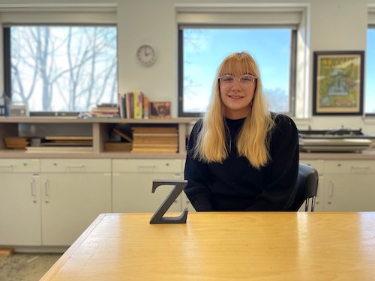Learning how to see things differently
Creativity is always bubbling over at Heuser Hall. From painting and ceramics to printmaking and photography, inspiration can be found in every studio. For students looking to pursue a degree in the fine arts or design, this is the gateway to creative ingenuity.
One of the foundational classes in the graphic design program, Typographic Design, teaches students the importance of creating legible and aesthetically pleasing designs. Beyond this, the course focuses on understanding the messaging for the intended audience, making it a critical building block for effective visual communication.
“Typography impacts the overall look and feel of a design,” said Assistant Professor Jae H. Chae, who joined the Department of Art and Design last fall. “It affects readability and comprehension and can convey meaning and mood through the use of font styles and sizes. A mastery of typography allows graphic designers to effectively convey their message and engage their audience,” he explained.
He wants his students to “learn how to see things differently,” and nowhere is this more evident than in his 3D typography assignment where students are encouraged to experiment and explore the limitations and potential of various materials to create letterforms.
“This project will help students expand their perspective from 2D shapes to 3D forms and provide them with the chance to experiment and explore the limitations and potential of various materials,” Chae said.
Junior Melaina McWhorter, chose to “build” the letter Z for her project. She used foam board for the base of the letter and glued craft paper with a woodgrain pattern to the outside.
McWhorter believes Chae’s best advice is to be confident in your work. “He guided us through practical solutions throughout the project,” she said. “I was able to come up with more ideas as he gave suggestions.” Students also collaborated and shared ideas, and in the end, they appreciated each other more and got a taste of what it’s like to work in a professional studio environment.
“The best part of the class is the critiques. I love viewing everyone's work because it gives me so many ideas for future projects and reminds me of what paths I could have taken that I simply overlooked.
“Class discussions are informative and fun," McWhorter said. "I find it extremely helpful that we have such a positive environment to discuss our ideas and learn how to improve our work. Nothing is considered a bad question.”
— Emily Potts
Assistant Professor Jae H. Chae in his office with 3D letters created by former students.


